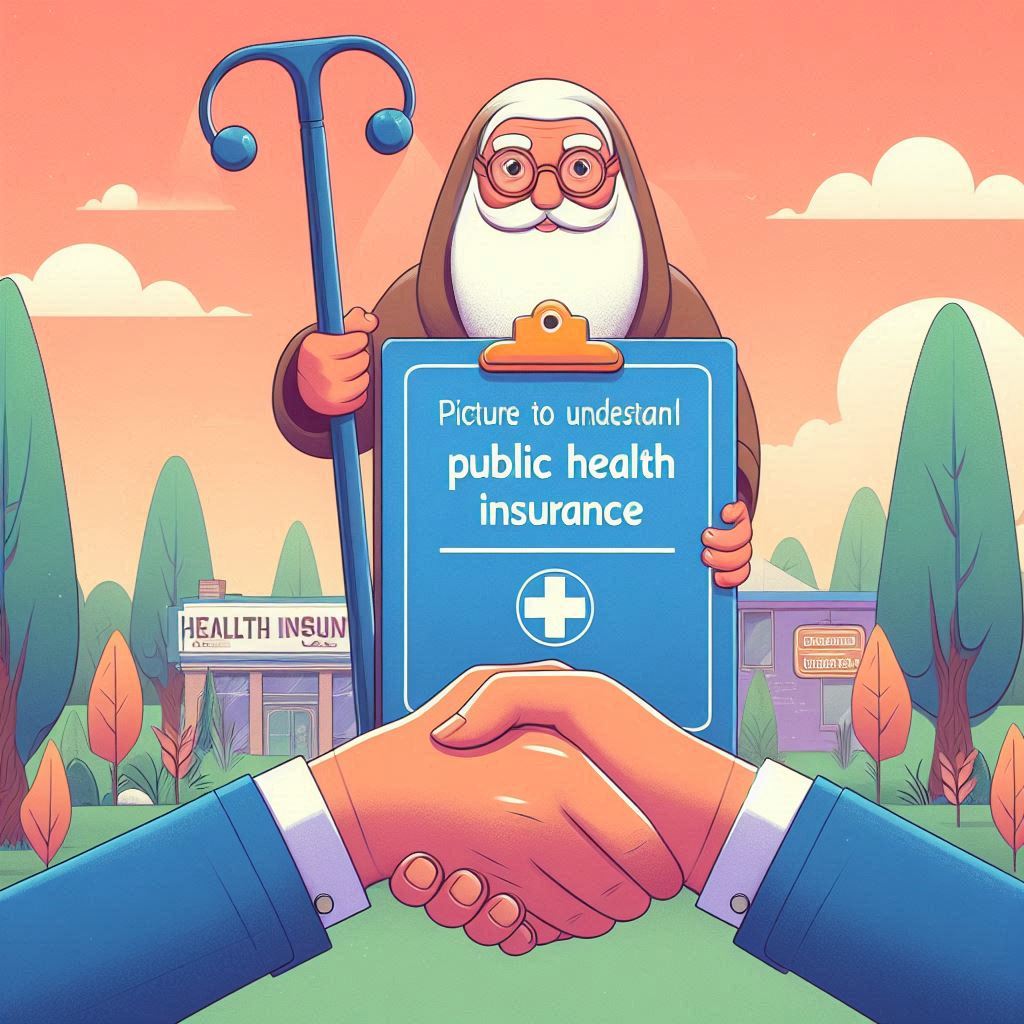Introduction
Health insurance is one of the most critical components of the modern healthcare system, providing individuals with the means to afford necessary medical treatments, preventive care, and emergency services. In the United States, public health insurance plays a pivotal role, offering millions of Americans access to affordable healthcare through government-supported programs. This article explores the range of public health insurance plans available, their importance in society, eligibility requirements, and their impact on individual and community health.
What is Public Health Insurance?
Public health insurance refers to health coverage programs that are funded and managed by the government, designed to provide healthcare access to citizens and residents, especially those who may not afford private insurance. Unlike private insurance, public health insurance is often subsidized by tax revenues, making it a crucial resource for low-income individuals, families, and specific vulnerable populations. Public health insurance generally covers essential health benefits, preventive care, hospitalization, and other necessary treatments.
Why Public Health Insurance Matters

Public health insurance is not just a support mechanism for individuals but also serves as a backbone of national health equity. By providing access to affordable healthcare for low-income families, elderly individuals, and people with disabilities, these plans reduce healthcare disparities and improve overall societal health. Additionally, public health insurance reduces the burden on emergency rooms by promoting preventive care, saving resources, and lowering healthcare costs over time.
Types of Public Health Insurance Plans
Several public health insurance programs exist, each tailored to different demographics and health needs. The most well-known plans include Medicaid, Medicare, and the Children’s Health Insurance Program (CHIP).
Medicaid
Medicaid is a state and federal program that provides health coverage for individuals and families with limited income and resources.
- Eligibility Requirements: Medicaid eligibility is largely based on income and household size, with income limits varying by state. In some states, Medicaid expansion has made it available to a broader group of people.
- Coverage and Services: Medicaid covers essential services like doctor visits, hospital stays, long-term care, and, in some cases, dental and vision care. Services vary by state, as each state administers its Medicaid program differently.
- Limitations: While Medicaid provides extensive coverage, some treatments and medications may require prior approval, and there may be limitations on certain procedures.
Medicare
Medicare is a federal health insurance program primarily for people aged 65 and older, but it also serves certain younger individuals with disabilities.
- Parts of Medicare: Medicare is divided into parts:
- Part A: Covers inpatient hospital stays and skilled nursing facilities.
- Part B: Covers outpatient services, such as doctor visits and preventive care.
- Part C (Medicare Advantage): An alternative to Original Medicare, often including additional benefits.
- Part D: Prescription drug coverage.
- Eligibility: Generally, anyone aged 65 or older who has paid into Social Security is eligible. Younger individuals with disabilities or certain medical conditions also qualify.
- Costs: While Medicare covers a significant portion of healthcare costs, enrollees often pay premiums, deductibles, and coinsurance for certain services.
Children’s Health Insurance Program (CHIP)
CHIP provides health coverage to low-income children in families who do not qualify for Medicaid but cannot afford private insurance.
- Importance for Families: CHIP ensures that children have access to comprehensive medical care, including immunizations, check-ups, and emergency services.
- Coverage: CHIP covers a broad range of services, similar to Medicaid, but eligibility requirements vary by state.
- Enrollment Process: Typically administered alongside Medicaid, CHIP has income limits that vary based on household size and the state of residence.
Eligibility Criteria for Public Health Insurance
Eligibility for public health insurance often depends on income, age, disability status, and family size. Medicaid has more income-based criteria, while Medicare primarily serves older adults and individuals with disabilities. Each state may have additional requirements and flexibility in defining eligibility for these programs.
Enrollment Process for Public Health Insurance
To enroll in public health insurance, individuals can typically apply through their state’s health insurance marketplace, healthcare.gov, or directly with their local Medicaid office. Documentation, such as proof of income, residency, and citizenship, may be required. Medicare enrollment is generally automatic for eligible individuals upon reaching the age of 65, while Medicaid and CHIP enrollment periods may vary by state.
Comparing Public Health Insurance and Private Health Insurance

When deciding between public and private health insurance, understanding the differences can be helpful. Public health insurance plans like Medicaid and Medicare are designed for broad accessibility, usually with lower costs or subsidies, while private health insurance plans are typically more personalized but can come with higher premiums.
- Cost Differences: Public health insurance generally has lower costs due to government subsidies, making it affordable for those with low or moderate incomes. Private insurance plans often have higher monthly premiums and require individuals to pay for additional features, but they can offer greater flexibility and specialized services.
- Coverage and Networks: Public plans may have limited networks of healthcare providers, with certain restrictions on accessing specialists. On the other hand, private plans often come with a broader choice of providers and more immediate access to specialists, though they are generally more costly.
- Access to Specialists and Elective Procedures: Private insurance often provides faster access to elective procedures and specialized care compared to public plans, which may require longer wait times or additional approvals. Public health insurance covers essential services and preventive care but may have limitations on non-essential procedures.
Pros and Cons of Public Health Insurance Plans
Public health insurance plans offer both advantages and disadvantages that are important to consider.
Advantages
- Affordability: Public health insurance is usually more affordable than private insurance, especially for low-income families and individuals.
- Accessibility: Programs like Medicaid and CHIP help ensure healthcare access for vulnerable populations, including children, pregnant women, and those with disabilities.
- Preventive Care Coverage: Most public plans offer preventive services like vaccinations, annual check-ups, and screenings, helping to reduce long-term healthcare costs.
Disadvantages
- Limited Provider Networks: Public health plans often restrict patients to a specific network of doctors and facilities, which can limit choices.
- Wait Times for Procedures: Public insurance plans may have longer waiting periods for non-emergency services or elective surgeries, as priority is given to critical and preventive care.
- Administrative Challenges: Navigating the enrollment and claim processes can be complex, and approval for certain treatments may be subject to administrative review and delays.
How Public Health Insurance Supports Vulnerable Populations
Public health insurance programs play an essential role in ensuring healthcare for vulnerable groups. These include low-income families, the elderly, individuals with disabilities, and children. Programs like Medicaid, CHIP, and Medicare provide comprehensive care and preventive services for those who may otherwise lack access to medical services.
- Impact on Children and Families: CHIP and Medicaid ensure that low-income children and pregnant women receive necessary healthcare services, contributing to healthier communities and reducing child mortality rates.
- Support for the Elderly and Disabled: Medicare provides senior citizens and individuals with disabilities access to affordable healthcare, reducing the financial strain of chronic conditions and long-term care.
- Case Studies and Examples: Many studies highlight how public health insurance helps reduce emergency room visits and prevents medical bankruptcies among families. For example, Medicaid expansion has been linked to lower rates of uninsured hospital visits and better health outcomes in states where it has been implemented.
Public Health Insurance and Preventive Care
Preventive care services are essential components of public health insurance plans, promoting long-term health and reducing healthcare costs. These services include immunizations, cancer screenings, and regular check-ups, all aimed at identifying and addressing health concerns early on.
- Importance of Early Intervention: Preventive care is proven to reduce the likelihood of serious illnesses, resulting in fewer emergency room visits and hospitalizations. Early intervention can also lead to faster recovery times and better health outcomes.
- Cost Savings Through Preventive Services: By focusing on prevention, public health insurance programs help reduce long-term healthcare expenses and alleviate the financial burden on individuals and the healthcare system.
Challenges Facing Public Health Insurance Systems

Despite the benefits, public health insurance programs face several challenges that affect their ability to deliver optimal care.
- Funding Issues: Public health insurance is primarily funded by federal and state governments, meaning budget constraints can impact program effectiveness. In some cases, limited funding leads to service cuts or stricter eligibility criteria.
- Increased Demand: As healthcare costs rise and more people rely on public insurance, demand for services has increased, often resulting in longer wait times and strained resources.
- Administrative and Policy Challenges: Changing political and policy landscapes can create administrative hurdles, with frequent adjustments to eligibility, benefits, and funding allocations impacting program stability and consistency.
Recent Policy Changes in Public Health Insurance
Public health insurance has been shaped by ongoing reforms, impacting who is eligible and what services are available. Recent legislative changes, such as Medicaid expansion in certain states, have broadened the scope of public health insurance, allowing more people to access affordable healthcare.
- Expanded Coverage Options: The expansion of Medicaid in certain states has increased access for low-income individuals who were previously ineligible. This has provided more families with preventive care and critical health services.
- Changes in Benefits and Eligibility: Certain policies have introduced new benefits, like mental health services, or adjusted income limits to make more people eligible for public health insurance.
- Future Policy Directions: Policymakers continue to debate potential changes, including a broader “Medicare for All” approach or other universal healthcare models aimed at extending public insurance coverage to more Americans.
The Impact of Public Health Insurance on Overall Healthcare Costs
Public health insurance plays a vital role in managing overall healthcare costs. By covering preventive care, regular check-ups, and essential services, public health programs help lower the burden on emergency services and reduce medical debt for families.
- Cost Savings for Individuals and Families: Public health insurance plans save families from incurring significant medical expenses, particularly for preventive and emergency care. This not only supports individual financial stability but also promotes greater economic productivity.
- Reducing the Burden on Emergency Services: Public health insurance allows people to seek medical attention early, preventing the need for emergency room visits and reducing strain on hospital resources.
- Economic Benefits: By improving public health, these insurance programs contribute to a healthier workforce and reduced absenteeism, leading to broader economic benefits for society.
Applying for Additional Benefits within Public Health Insurance
Beyond standard healthcare services, some individuals can apply for supplementary benefits under public health insurance programs. For example, dual eligibility for both Medicare and Medicaid can provide additional support for low-income seniors, including assistance with prescriptions, mental health services, and long-term care.
- Prescription Discounts and Mental Health Services: Many public insurance plans offer additional benefits, such as discounted prescription drugs, therapy, and counseling services, making comprehensive care more accessible.
- Medicaid Expansion and Dual Eligibility: Some states have implemented Medicaid expansion, allowing a broader range of residents to qualify. Dual eligibility, which allows individuals to receive both Medicare and Medicaid benefits, provides extra support for low-income seniors and those with chronic health conditions.
Future of Public Health Insurance
The landscape of public health insurance is expected to continue evolving as policymakers and health experts seek ways to address the healthcare needs of an aging population and a rapidly changing economy.
- Potential Healthcare Reforms: Proposed reforms such as expanding Medicare to a broader population or creating a public option in the health insurance marketplace could provide more affordable options to a larger group of people.
- Advances in Technology and Telemedicine: As digital healthcare technology advances, telemedicine and online resources may become integrated into public health insurance plans, making it easier for individuals to access preventive and specialist care.
- A Move Toward Universal Coverage: Some policymakers advocate for a single-payer system or a “Medicare for All” model that would offer universal public health insurance, potentially reshaping the entire healthcare landscape in the U.S.
Conclusion
Public health insurance is a cornerstone of accessible healthcare, ensuring that millions of Americans can receive essential medical services, regardless of income. By covering preventive care, hospital services, and critical medical treatments, public health insurance plays a crucial role in promoting a healthier society. While there are challenges and limitations to these programs, the benefits far outweigh the drawbacks for many individuals. Understanding the different public health insurance plans, eligibility criteria, and application processes empowers individuals to make informed choices about their healthcare needs.
FAQs
- What are the primary types of public health insurance in the U.S.?
- The main types are Medicaid, Medicare, and the Children’s Health Insurance Program (CHIP). Each program has different eligibility requirements and covers specific groups.
- Who qualifies for Medicaid, and how do you apply?
- Medicaid eligibility is income-based, with some variations depending on the state. Applications can be submitted through healthcare.gov or the state’s Medicaid office.
- Can you have both public and private health insurance at the same time?
- Yes, it’s possible to have both, especially if one serves as primary coverage and the other as secondary. Some people may use private insurance to cover services not included in public insurance.
- What services does public health insurance cover?
- Most public health plans cover hospital visits, preventive care, essential treatments, and, in some cases, prescription drugs, dental, and vision services.
- How has public health insurance changed over the last few years?
- Recent policy changes have expanded Medicaid in some states, added benefits like mental health services, and redefined eligibility requirements, allowing more people to qualify for coverage.
